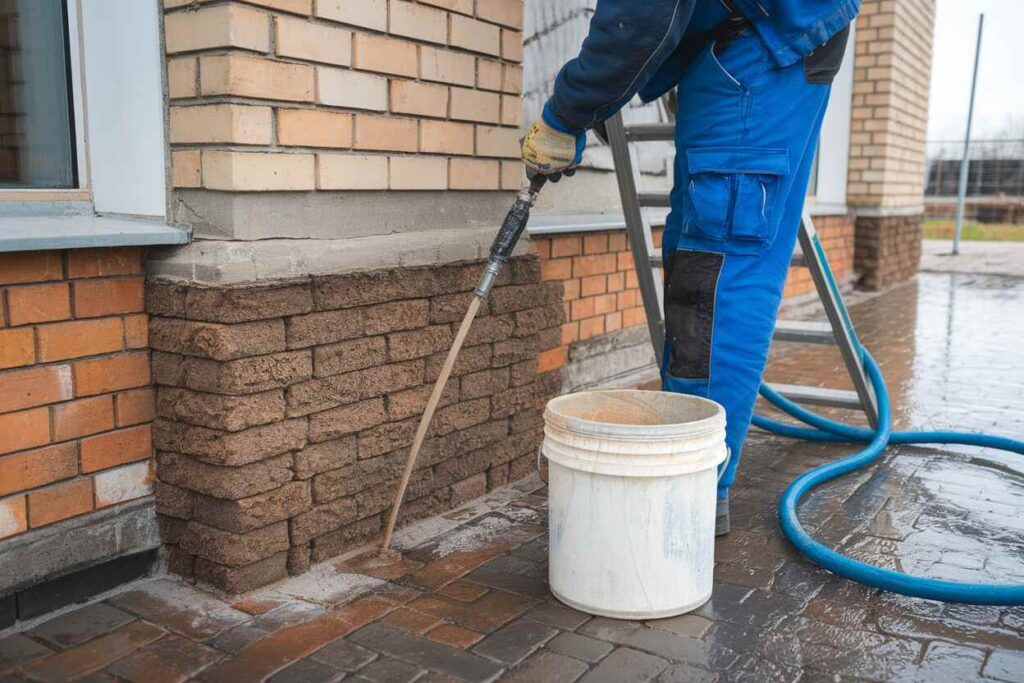As a homeowner, one of the most important aspects of your property is ensuring that your foundation remains strong and intact. A highly effective method to safeguard your foundation is by applying waterproofing. However, despite its importance, many homeowners hold misconceptions about foundation waterproofing.
These misconceptions can result in postponed upkeep or expensive repairs in the future. Let’s clarify five widespread myths about foundation waterproofing and uncover the reality behind them.
Myth 1: Foundation Waterproofing is Only Necessary in Areas with Heavy Rain.
One of the most common myths is that foundation waterproofing is only necessary in areas that receive a lot of rainfall. While it’s true that excess water can put a strain on a foundation, there are several other factors to consider when deciding whether to invest in waterproofing. Water damage doesn’t only come from rainfall. It can also occur from snowmelt, humidity, and even groundwater seepage.
If you live in an area with seasonal snowmelt, you’re still at risk of foundation issues. When snow melts, it can infiltrate your foundation, especially if your drainage system isn’t up to the task. Furthermore, high humidity can cause moisture to accumulate in the soil around your foundation, increasing the risk of water seepage.
Regardless of the amount of rain your area receives, if your foundation is exposed to moisture from any source, waterproofing is a smart preventive measure. It’s about keeping the foundation dry and safe from all types of moisture, not just rain.
Myth 2: If My Basement Isn’t Leaking, I Don’t Need Waterproofing.
Another myth is that foundation waterproofing is only necessary if there’s visible water damage, such as leaking in the basement. While it’s true that water leakage is a clear sign that waterproofing is needed, waiting for leaks to appear can be a costly mistake.
Foundation water damage typically begins as a minor issue and progressively escalates over time. You might not see visible leaks, but moisture can still be affecting your foundation. The presence of dampness, high humidity levels, or musty odors in your basement or crawl space can indicate that water is already infiltrating your foundation. Left unaddressed, these issues can lead to mold growth, mildew, and even structural damage that can compromise the integrity of your home.
Waterproofing your foundation is a preventive measure, safeguarding your home from potential problems before they become visible. It’s much easier and cheaper to waterproof your foundation before problems arise than to deal with extensive damage later.
Myth 3: Waterproofing is Expensive and Not Worth the Investment.
Many homeowners are hesitant to invest in foundation waterproofing due to the perception that it is expensive. However, when weighing the long-term advantages of waterproofing, the expense becomes entirely worthwhile. Consider waterproofing as a valuable investment in maintaining the structural strength of your home.
Without proper waterproofing, your foundation is at risk of cracks, water damage, mold growth, and even shifting soil. These issues can lead to extremely expensive repairs, not to mention the potential health risks posed by mold and mildew. By opting for waterproofing early, you’re avoiding expensive repairs and helping to prolong the lifespan of your home.
Moreover, waterproofing can improve your home’s overall energy efficiency. Moisture in the foundation can contribute to uneven temperatures in your basement or crawl space, leading to increased heating or cooling costs. Waterproofing helps regulate humidity levels and temperature, ultimately saving you money on energy bills.
Myth 4: Interior Waterproofing Can Solve All My Problems.
When it comes to foundation waterproofing, many homeowners mistakenly believe that interior waterproofing alone can resolve all water intrusion issues. Although interior waterproofing solutions like sump pumps and drainage systems can manage water that enters your home, they don’t tackle the underlying issue—moisture seeping in through the outside of the foundation.
Interior waterproofing might provide a temporary solution by managing water that comes in through cracks or gaps in the foundation, but it doesn’t prevent water from infiltrating your home in the first place. For a long-lasting solution, exterior waterproofing is essential. This process includes installing a waterproof membrane or coating on the exterior of your foundation to stop water from penetrating. Additionally, proper drainage systems, such as French drains, should be installed around the foundation to divert water away from the house.
Exterior waterproofing is often the most effective approach to keeping your foundation dry and preventing costly damage in the future. It tackles the issue at its origin, guaranteeing that your home stays protected from moisture.
Myth 5: Once Waterproofing is Completed, I Never Need to Worry About It Again.
After investing in waterproofing, some homeowners believe that it’s a one-time fix and that they never have to worry about it again. Unfortunately, this is far from the truth. Like any system in your home, foundation waterproofing requires ongoing maintenance and monitoring.
Over time, waterproofing materials can wear down due to exposure to weather conditions, soil movement, or even natural wear and tear. Additionally, landscaping changes or shifts in the soil around your home can impact the effectiveness of your waterproofing system. It’s important to inspect your foundation periodically and ensure that the waterproofing system is still functioning as intended.
Regular maintenance, such as checking for cracks, ensuring proper drainage, and reapplying waterproofing membranes when necessary, is essential to maintaining the health of your foundation. Identifying minor problems early can help you avoid significant repairs down the road.
Conclusion:
Foundation waterproofing plays a crucial role in safeguarding your home from water damage. By dispelling these common myths, homeowners can make better-informed choices to maintain their foundation in optimal condition. Whether you’re dealing with rain, snowmelt, or groundwater seepage, waterproofing is an investment in the longevity and structural integrity of your home. By taking preventive measures against water damage, you can ensure your home stays safe, dry, and protected for many years.

